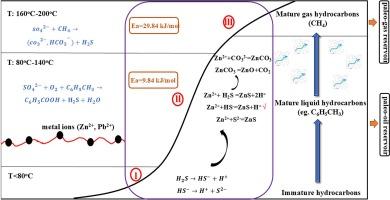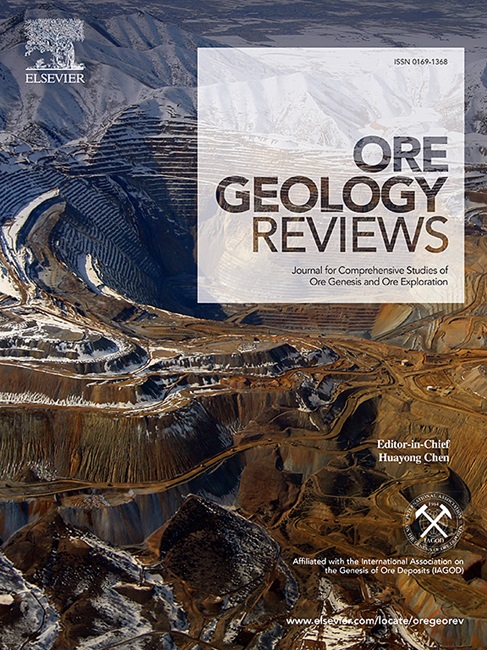Impact of temperature on sphalerite chemistry: Simulation experiments of sphalerite in MVT Zn-Pb sulfide deposits in the Beiba Dome, northern Sichuan Basin, China
IF 3.2
2区 地球科学
Q1 GEOLOGY
引用次数: 0
Abstract
Many sedimentary metal deposits are rich in organic matter, and some organic deposits are metal deposits themselves. These metal deposits, represented by MVT Zn-Pb deposits, are widely distributed in the world, and their industrial types (Pb + Zn > 5 %) are also very rich, which has important theoretical and economic significance. However, there is no systematic research on the metallogenic mechanism of MVT Zn-Pb deposits in the participating organic matter. Therefore, geochemical simulation experiments and thermodynamic calculations have been used to examine the role of organic matter in reconstructing the ore-forming process of MVT Zn-Pb sulfide deposits. Additionally, the precipitation chemistry of sphalerite under the mineralization process mediated by organic matter is explained. Guided by the evidence on the homogenization temperature of fluid inclusion, the temperature range, from 60 °C to 200 °C, has drawn a close relationship between the temperature and the ore-forming mechanism. Notably, this reflects sphalerite’s chemical composition and morphology, even assisting in interpreting its chemical formation. The results showed that 80 °C is the beginning temperature for ZnS formation calculated from the inductively coupled plasma mass spectrometry analysis (ICP-MS) under the precipitation simulation experiments with the participation of organic matter. With the increased temperature, the rate of ZnS formation showed a trend of rapid growth in the early stage (80–140 °C) and relatively slow in the later stage (160–200 °C). This finding suggests a closer coupling relationship between metal mineralization and the maturation-genesis of organic matter, mainly the formation of the ancient oil reservoir. Following the continued increase in temperature, the morphology of ZnS was significantly different from that of the scanning electron microscope (SEM), with an apparent fine granular structure at high temperature. Likewise, more ZnO was also found through the X-ray photoelectron spectroscopy analysis (XPS), reducing the purity of the ZnS in sphalerite. Thus, this study helps reveal the metallogenic mechanism of MVT Zn-Pb sulfide deposits from the viewpoint of sphalerite chemistry under the participation of organic matter from temperature change. Furthermore, it provides a valuable theoretical and experimental basis for the later prospecting of the metal deposits.

温度对闪锌矿化学性质的影响:中国四川盆地北部北坝穹窿 MVT 锌铅硫化物矿床中闪锌矿的模拟实验
许多沉积金属矿床都富含有机质,有些有机矿床本身就是金属矿床。以 MVT Zn-Pb 矿床为代表的这些金属矿床在世界上分布广泛,其工业类型(Pb + Zn > 5 %)也非常丰富,具有重要的理论和经济意义。然而,对参与有机质的 MVT Zn-Pb 矿床的成矿机制还没有系统的研究。因此,利用地球化学模拟实验和热力学计算研究了有机质在重构 MVT 硫化锌矿床成矿过程中的作用。此外,还解释了在有机质介导的成矿过程中闪锌矿的沉淀化学过程。在流体包裹体均化温度证据的指导下,温度范围从 60 °C 到 200 °C,得出了温度与成矿机制之间的密切关系。值得注意的是,这反映了闪锌矿的化学成分和形态,甚至有助于解释其化学形成。结果表明,在有有机物参与的沉淀模拟实验中,通过电感耦合等离子体质谱分析(ICP-MS)计算得出的 80 °C 是形成 ZnS 的起始温度。随着温度的升高,ZnS 的形成速率呈现出前期(80-140 °C)快速增长、后期(160-200 °C)相对缓慢的趋势。这一发现表明,金属矿化与有机质的成熟-生成(主要是古油藏的形成)之间的耦合关系更为密切。随着温度的持续升高,ZnS 的形态与扫描电子显微镜(SEM)观察到的明显不同,在高温下呈明显的细颗粒状结构。同样,通过 X 射线光电子能谱分析(XPS)也发现了更多的氧化锌,降低了闪锌矿中 ZnS 的纯度。因此,本研究有助于从闪锌矿化学角度揭示温度变化导致有机物参与的 MVT 锌铅硫化物矿床的成矿机制。此外,它还为该金属矿床的后期勘探提供了宝贵的理论和实验依据。
本文章由计算机程序翻译,如有差异,请以英文原文为准。
求助全文
约1分钟内获得全文
求助全文
来源期刊

Ore Geology Reviews
地学-地质学
CiteScore
6.50
自引率
27.30%
发文量
546
审稿时长
22.9 weeks
期刊介绍:
Ore Geology Reviews aims to familiarize all earth scientists with recent advances in a number of interconnected disciplines related to the study of, and search for, ore deposits. The reviews range from brief to longer contributions, but the journal preferentially publishes manuscripts that fill the niche between the commonly shorter journal articles and the comprehensive book coverages, and thus has a special appeal to many authors and readers.
 求助内容:
求助内容: 应助结果提醒方式:
应助结果提醒方式:


